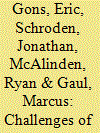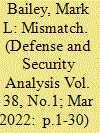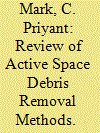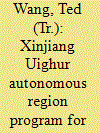|
|
|
Sort Order |
|
|
|
Items / Page
|
|
|
|
|
|
|
| Srl | Item |
| 1 |
ID:
113109


|
|
|
|
|
| Publication |
2012.
|
| Summary/Abstract |
Measuring nationwide progress of counterinsurgency operations in Afghanistan using violence trends is difficult due to several factors: aggregation of data to the national level may obfuscate disparate local trends; the observed seasonality in violence makes comparisons difficult and may obscure progress; and short-term spikes or troughs - attributable to weather, military operations and tempo, or holiday periods - heavily influence simple averaging schemes. Despite these challenges, proper understanding of violence statistics is critical to estimating the effectiveness of military forces added during a surge or redeployed as part of transition. This article explores methods for analyzing observed violence trends to identify causal factors, to provide a comparable baseline, and to inform assessments at appropriate levels of aggregation. One methodology for seasonal adjustment of violence data is discussed and shown to provide a logical baseline for examining trends. An ordinary least squares regression model is developed and implemented using time-series violence data.
|
|
|
|
|
|
|
|
|
|
|
|
|
|
|
|
| 2 |
ID:
184079


|
|
|
|
|
| Summary/Abstract |
Large-scale illegal fishing commenced in Australian coastal reefs 1970. Since, the Royal Australian Navy (RAN) has been “out of synch” with matching its Tier 2 constabulary vessels to their mission. The pattern is that “mission goalposts” shift post-acquisition, reflecting changes to UNCLOS. Post-WWII, the RAN employed wartime escorts in patrol roles, and wartime launches for littoral constabulary. The RAN has recreated this mix in the twentyfirst century. This paper traces this process and associated problems. Minimum resources are assigned to constabulary functions in peacetime, yet the units involved are arguably the most operational and politically sensitive. Vessel unsuitability has consistently meant personnel problems, over-use of constabulary vessels, and high maintenance costs. Australia's strategic situation is deteriorating towards a point where the rising risk demands mobilisation responses. This would include rapid acquisition of large numbers of Tier 2 assets to meet existing and conflict low-mix roles.
|
|
|
|
|
|
|
|
|
|
|
|
|
|
|
|
| 3 |
ID:
169313


|
|
|
|
|
| Summary/Abstract |
This article gives an overview of the active space debris removal methods that are currently in development. Orbital debris removal has become a very critical part of the commercial and scientific space management. It is an aggregating risk which needs to be immediately addressed to prevent loss of spacecraft to debris collision. The various concepts and methods which tend to bring the accumulating risk to a halt have been classified and reviewed. They are classified into collective, laser-based, ion-beam shepherd-based, tether-based, sail-based, satellite-based, unconventional, and dynamical systems-based methods. The dynamical systems-based method is a contemporary concept, which is developing at a rapid pace. Recent trends were analyzed to ascertain the evolution of the active space debris removal programs. State-of-the-art methods are essentially required to address the various sizes of space debris that need to be removed. This brings a huge opportunity in the area, which includes discovering commercially viable options, cleaning orbital regions, and optimizing crowded satellite orbits.
|
|
|
|
|
|
|
|
|
|
|
|
|
|
|
|
| 4 |
ID:
129276


|
|
|
|
|
| Publication |
2012.
|
| Summary/Abstract |
The article offers information regarding the Expanded Enrollments program in Junior Middle School Classes Within the Xinjiang Uighur Autonomous Region, China, in 2011-14. In accordance with the expanded enrollment program, the scale of enrollments of expanded regional junior class is expected to reach 10,000 per year in 2014, which will provide opportunities for the children of farmers and ranchers to get quality basic education resources and convey more quality students to the interior region.
|
|
|
|
|
|
|
|
|
|
|
|
|
|
|
|
|
|
|
|
|